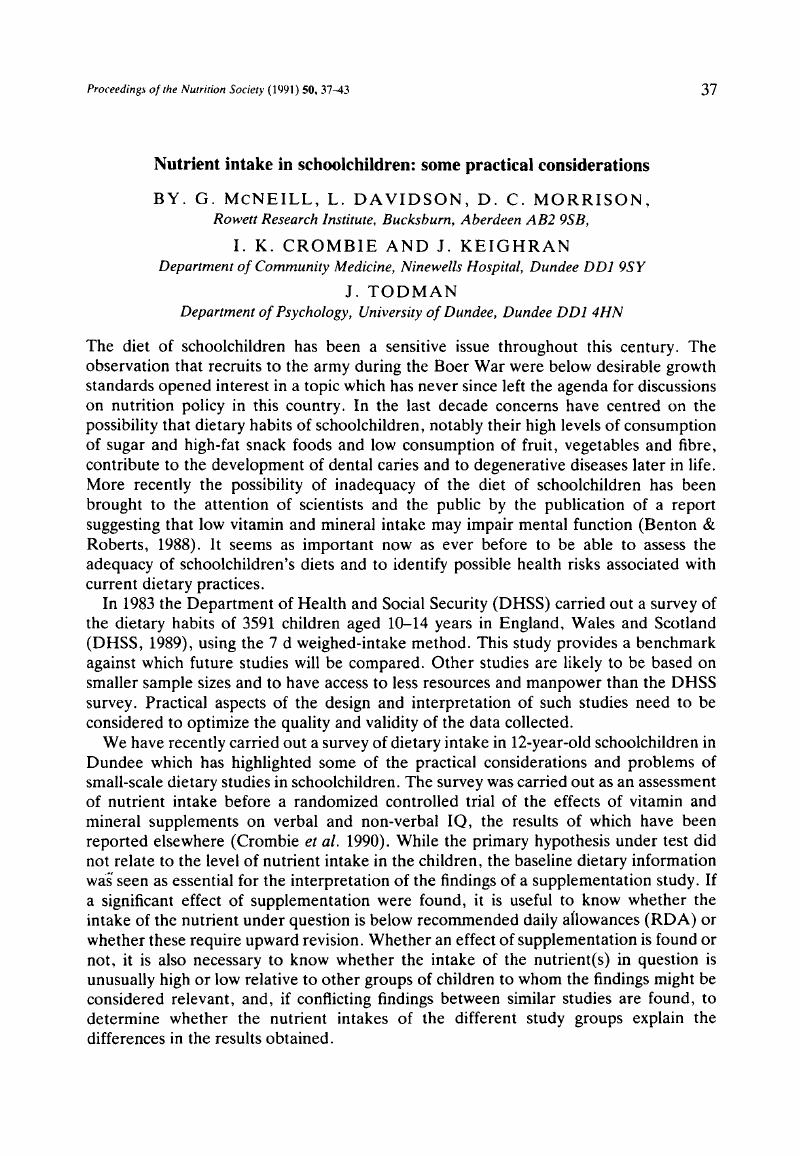Crossref Citations
This article has been cited by the following publications. This list is generated based on data provided by Crossref.
Payne, J. A.
and
Belton, N. R.
1992.
Nutrient intake and growth in preschool children. I, Comparison of energy intake and sources of energy with growth.
Journal of Human Nutrition and Dietetics,
Vol. 5,
Issue. 5,
p.
287.
Rugg‐Gunn, A. J.
Adamson, A. J.
Appleton, D. R.
Butler, T. J.
and
Hackett, A. F.
1993.
Sugars consumption by 379 11–12‐year‐old English children in 1990 compared with results in 1980.
Journal of Human Nutrition and Dietetics,
Vol. 6,
Issue. 5,
p.
419.
Ruxton, C. H. S.
Kirk, T. R.
Belton, N. R.
and
Holmes, M. A. M.
1993.
Micronutrient intakes in schoolchildren—is supplementation necessary?.
Journal of Human Nutrition and Dietetics,
Vol. 6,
Issue. 4,
p.
373.
Moynihan, P. J.
Anderson, C.
Adamson, A. J.
Rugg‐Gunn, A. J.
Appleton, D. R.
and
Butler, T. J.
1994.
Dietary sources of iron in English adolescents.
Journal of Human Nutrition and Dietetics,
Vol. 7,
Issue. 3,
p.
225.
Dennison, Catherine M.
and
Shepherd, Richard
1995.
Adolescent food choice: an application of the Theory of Planned Behaviour.
Journal of Human Nutrition and Dietetics,
Vol. 8,
Issue. 1,
p.
9.
Turner, Sheila
Mayall, Berry
and
Mauthner, Melanie
1995.
One big rush: dinner-time at school.
Health Education Journal,
Vol. 54,
Issue. 1,
p.
18.
Ruxton, C. H. S.
O'sullivan, K. R.
Kirk, T. R.
and
Beltons, N. R.
1996.
The contribution of breakfast to the diets of a sample of 136 primary-schoolchildren in Edinburgh.
British Journal of Nutrition,
Vol. 75,
Issue. 3,
p.
419.
Moynihan, Paula
Adamson, Ashley
Rugg, Andrew
Appleton, David
and
Butler, Timothy
1996.
Dietary sources of calcium and the contribution of flour fortification to total calcium intakein the diets of Northumbrian adolescents.
British Journal of Nutrition,
Vol. 75,
Issue. 3,
p.
495.
Ruxton, C. H. S.
Kirk, T. R.
and
Belton, N. R.
1996.
Energy and nutrient intakes in a sample of 136 Edinburgh 7–8 year olds: a comparison with United Kingdom dietary reference values.
British Journal of Nutrition,
Vol. 75,
Issue. 2,
p.
151.
Sherratt, Emma
1996.
High Fat Intakes Are Unhealthy but do Children Know?.
Educational Review,
Vol. 48,
Issue. 2,
p.
163.
Douglas, Lesley
1998.
Children’s food choice.
Nutrition & Food Science,
Vol. 98,
Issue. 1,
p.
14.
Woringer, Virgile
and
Cantieni, Anne-Marie
1998.
Equilibre nutritionnel du petit-d�jeuner d'enfants de 7 � 11 ans: Comparaison entre une action de sant� � l'�cole et l'alimentation au domicile.
Sozial- und Pr�ventivmedizin SPM,
Vol. 43,
Issue. 2,
p.
59.
Coulson, Neil S
Eiser, Christine
and
Eiser, J Richard
1998.
Nutrition education in the National Curriculum.
Health Education Journal,
Vol. 57,
Issue. 1,
p.
81.
Wrieden, Wendy L
and
Moore, Edward J H
1998.
The impact of a food and health education programme on the dietary habits of young Scottish adolescents.
International Journal of Health Promotion and Education,
Vol. 36,
Issue. 4,
p.
103.
Boaz, Annette
Ziebland, Sue
Wyke, Sally
and
Walker, Jeremy
1998.
A 'five-a-day' fruit and vegetable pack for primary school children. Part II: controlled evaluation in two Scottish schools.
Health Education Journal,
Vol. 57,
Issue. 2,
p.
105.
Hampl, Jeffrey S
Taylor, Christopher A.
and
Johnston, Carol S.
1999.
Intakes of Vitamin C, Vegetables and Fruits: Which Schoolchildren Are at Risk?.
Journal of the American College of Nutrition,
Vol. 18,
Issue. 6,
p.
582.
Chan, Wynnie
1999.
Nutrition requirements for children.
Nursing and Residential Care,
Vol. 1,
Issue. 3,
p.
146.
Gallagher, Kelly
2000.
Dietary practices and nutrition knowledge of adolescents from contrasting social backgrounds.
Journal of Consumer Studies & Home Economics,
Vol. 24,
Issue. 4,
p.
207.
Noble, Carol
Corney, Michael
Eves, Anita
Kipps, Michael
and
Lumbers, Margaret
2000.
Food choice and school meals: primary schoolchildren's perceptions of the healthiness of foods and the nutritional implications of food choices.
International Journal of Hospitality Management,
Vol. 19,
Issue. 4,
p.
413.
Gallagher, Kelly
2000.
Dietary practices and nutrition knowledge of adolescents from contrasting social backgrounds.
Journal of Consumer Studies and Home Economics,
Vol. 24,
Issue. 4,
p.
207.


